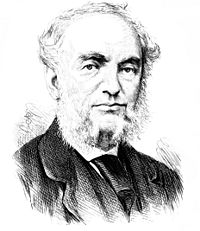Balfour Stewart facts for kids
Quick facts for kids
Balfour Stewart
|
|
|---|---|
 |
|
| Born | 1 November 1828 |
| Died | 19 December 1887 (aged 59) Ballymagarvey, Balrath, County Meath, Ireland
|
| Nationality | Scottish |
| Citizenship | British |
| Alma mater | University of St. Andrews University of Edinburgh |
| Known for | Heat, Meteorology, & Terrestrial Magnetism |
| Awards | Rumford Medal (1868) |
| Scientific career | |
| Fields | Physics |
| Institutions | Kew Observatory, Owens College, Manchester |
| Doctoral advisor | James David Forbes |
Balfour Stewart (born November 1, 1828 – died December 19, 1887) was a Scottish scientist. He was a physicist (someone who studies how matter and energy work) and a meteorologist (someone who studies weather and atmosphere).
He was known for his work on radiant heat, which is how heat travels through space. For this important work, he received the Rumford Medal in 1868 from the Royal Society. In 1859, he became the director of the Kew Observatory. Later, he became a physics professor at Owens College, Manchester. He taught there until he passed away in Ireland in 1887. Balfour Stewart also wrote several popular science textbooks. He even wrote an article about "Terrestrial Magnetism" for a famous encyclopedia called the Encyclopædia Britannica.
Contents
His Life and Work
Balfour Stewart was born in Leith, Scotland, on November 1, 1828. His father, William Stewart, was a tea merchant. Balfour studied Physics at the University of St Andrews and the University of Edinburgh.
In 1856, he became an assistant to James David Forbes, another important scientist. Forbes was very interested in heat, meteorology (weather), and terrestrial magnetism (Earth's natural magnetic field). Stewart also focused on these areas.
Studying Heat
Stewart spent a lot of time studying radiant heat. By 1858, he made an important discovery. He found that heat doesn't just radiate from the surface of an object. Instead, it radiates from inside the object too. He also showed that an object's ability to give off heat (radiate) is equal to its ability to take in heat (absorb). This was a big step forward in understanding how heat works.
Because of this work, he was given the Rumford Medal in 1868. He had already become a member of the Royal Society six years earlier. He also wrote other papers about physics, including topics like how a disc heats up when it spins fast in a vacuum.
Kew Observatory and Manchester
In 1859, Stewart became the director of the Kew Observatory. This made him even more interested in weather and Earth's magnetism. In 1870, he was badly hurt in a train accident. Despite this, he was chosen to be a physics professor at Owens College, Manchester. He stayed in this job until his death on December 19, 1887, near Drogheda, Ireland.
Besides his scientific papers, he wrote many successful science textbooks. He also wrote the article on "Terrestrial Magnetism" for the ninth edition of the Encyclopædia Britannica. With another professor, Peter Guthrie Tait, he wrote a book called The Unseen Universe. This book explored how science and religion could exist together. Stewart was a religious man and was involved with the Society for Psychical Research, which studied unexplained mental abilities.
Great Magnetic Storms of 1859
Balfour Stewart recorded some amazing events at the Kew Observatory in 1859. These were huge disturbances in Earth's magnetic field, now called geomagnetic storms. One happened on August 28, 1859, and another on September 2, 1859. The Kew Observatory had special equipment that could continuously record these magnetic changes.
Stewart noticed that there were "two distinct well-marked disturbances." Each one started suddenly and then slowly faded away. These two magnetic storms happened at the same time as two large aurora displays. Auroras are beautiful lights in the sky, like the Northern Lights.
The second magnetic storm was caused by what we now call the Carrington Event. This was a very powerful solar flare (a huge burst of energy from the Sun). Two astronomers, Richard Christopher Carrington and Richard Hodgson, saw this flare through their telescopes on September 1, 1859.
Stewart also reported a smaller magnetic disturbance that happened at the exact moment Carrington saw the solar flare. He thought it was possible that the event on the Sun and the magnetic disturbance on Earth were connected. This was a very important idea at the time.
Today, we know that solar flares send out X-rays that reach Earth in about 8 minutes. These X-rays cause a sudden change in Earth's upper atmosphere, which creates a small magnetic disturbance. This is called a Solar Flare Effect (SFE). The larger magnetic storm that followed about 17.5 hours later was caused by a coronal mass ejection (CME). A CME is a giant cloud of solar material that explodes from the Sun. It travels slower than X-rays but can cause much bigger magnetic storms when it hits Earth.
Stewart's observations helped scientists understand the powerful connections between the Sun and Earth's magnetic field.
Writings
- Elementary Treatise on Heat (1866)
- Lessons in Elementary Physics (1871)
- Physics (1872)
- The Unseen Universe (1875)
- Paradoxical Philosophy: A Sequel to the Unseen Universe (1878)
- The Conservation of Energy (1875)
- Lessons in Practical Physics with W. H. Gee, (volume i, 1885; volume ii, 1887)
- An Elementary Treatise on Heat (1888)
See also
 In Spanish: Balfour Stewart para niños
In Spanish: Balfour Stewart para niños

